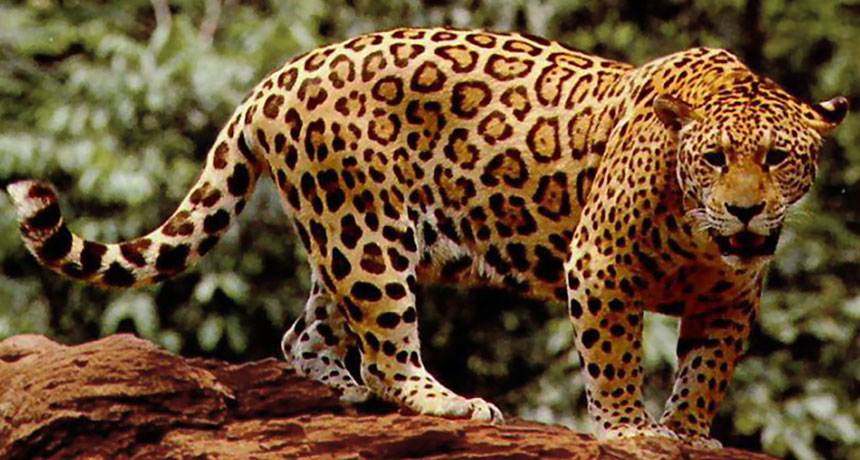For jaguars, armored prey is no obstacle

The jaguar’s ability to quickly kill dangerous prey lets the cats take down prey that other animals would avoid, a new study finds.
USFWS/Wikimedia Commons
- More than 2 years ago
A jaguar is a bit different from other carnivores — even from other cats. Its head is big for its body size, which is also a bit bigger than you might expect for a feline. It has thick canine teeth and strong muscles in its head, which combine to produce a powerful bite. And jaguars kill their prey differently than other big cats. Lions, tigers and other big kitties bite the underside of their prey’s neck and hold on until the animal suffocates and dies. Jaguars have a different killing style: They go for the back of the neck or skull, which damages the spine and incapacitates their prey.
Scientists had proposed that this suite of adaptations, from jaguar morphology to killing style, help jaguars eat reptiles. Jaguars are the only big cats to regularly eat reptiles, and big teeth and strong muscles are needed to get through thick reptile skin. But a new study suggests that those adaptations instead allow jaguars to take down really dangerous animals and those that carry their own armor — only some of which are reptiles. The study appears June 17 in the Journal of Natural History.
It’s difficult to determine what prompted the evolution of a certain trait in an animal. Its current environment doesn’t matter since evolution is a process of the past. But that environment can provide clues to what happened. So Everton Miranda of the Federal University of Mato Grosso in Cuiabá, Brazil, and colleagues looked through the scientific literature for studies of jaguar diet, finding 36 and focusing on the 28 that included 16 or more cats. They then looked for patterns of what the cats were eating and where that occurred over their range in Central and South America.
A jaguar dives into a river to catch a caiman dinner. Classicgrag/YouTube |
Location matters for jaguar diet; the big cats take advantage of what is available. In places where piglike peccaries are available, jaguars go for those, even if other prey is running around. And the cats’ killing method is a definite advantage. Peccaries are social animals, and a quick kill is needed if a jaguar is to avoid attack by the rest of the peccary herd. By killing fast, a jaguar has time to retreat from any potential attack. And if the herd chases a jaguar off, it can return to scavenge the body when the peccaries finally go away.
But when peccaries are rare or completely unavailable, jaguars fill their menu with other, often dangerous or heavily armored prey. In Central America, where jaguars tend to be smaller, these cats go for armadillos and anteaters. On floodplains and turtle nesting beaches, the cats attack turtles. And on the floodplains of Mamirauá in the Brazilian Amazon, jaguars feast on the only big animal available to them and one that is highly abundant — the alligator relative called the caiman.
The thick hides of caimans and the strong shells on turtles are “formidable obstacles to predation,” the researchers note, and that’s probably the reason why, when some other prey is available, jaguars go for that, even if that animal is deadly or has its own set of armor to break through.





